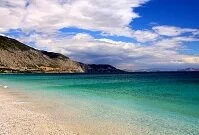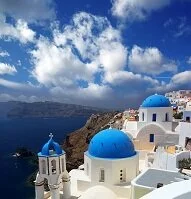Geography, Weather, & Wildlife of Greece
Geography

Greek coast
Greece is located in southern Europe at the end of the Balkan Peninsula on the Mediterranean Sea. It is bordered by Albania (west), Turkey (east), Bulgaria (north), and Macedonia (north).
Geographically, Greece is fairly elevated, yet much of the country is on the Mediterranean Sea meaning there is a lot of change in the country vertically. Even many of the country's islands gain a lot of elevation in little space. This creates a very hilly and, in some places, mountainous country. These mountains also hamper transportation by land so most people live on or near the coasts where water transportation is much more accessible.
Weather

Church on Santorini
As a country on the Aegean Sea and Mediterranean Sea, Greece has a reputation of being tropical, but winters can get cool, especially with the winds off of the water. The country, particularly some of the southern islands, receive incredible heat during much of the summer and even winters aren't too cold relative to mainland Europe, but the mountains can get snow that remains for months at a time.
Winters in Greece are mild compared to much of Europe as Athens generally reaches daily highs of about 55-58° F (13-14° C) during this time, although nights can get colder. The inland mountains and those on Crete tend to be even colder than this and these regions will get snow. However, many of the flat southern islands, particularly along their coasts, remain significantly warmer, but the breezes off the water can make even the islands uncomfortable during the winter.